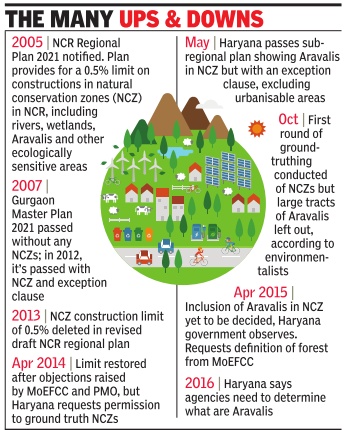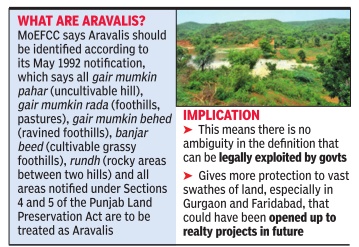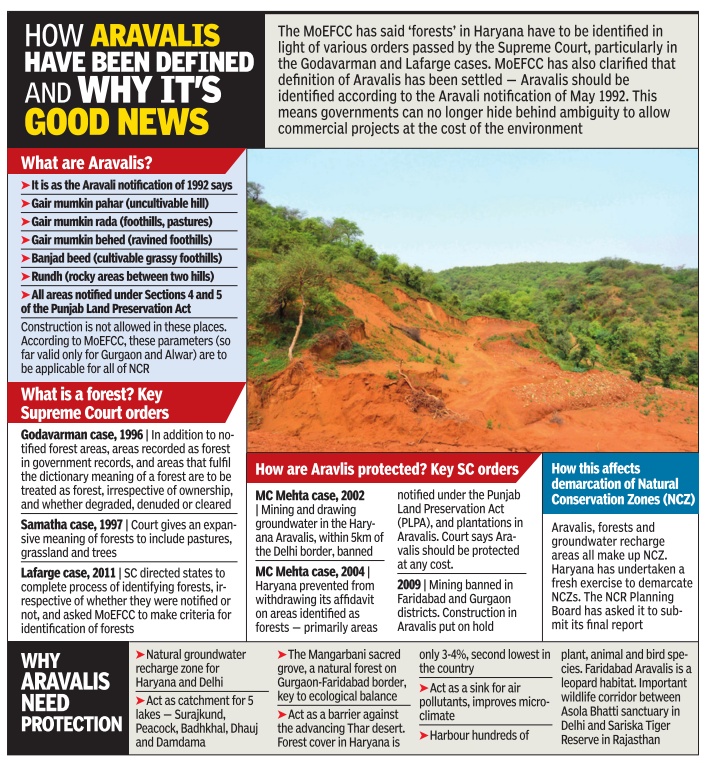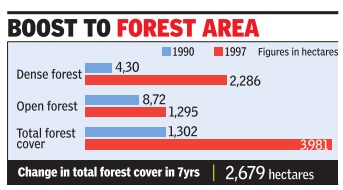Aravali range
This is a collection of articles archived for the excellence of their content. Readers will be able to edit existing articles and post new articles directly |
Contents |
What are the Aravalis?
The 1992 definition
See graphics:
What are Aravalis-I
What are the Aravalis- II
Master Plan 2021 Defines Conservation Zones, Removes Ambiguity In Definition & Scope
The definition of Aravalis, whose definition of Aravalis, whose ambiguous interpretation has for years led to many court battles for the protection of the ecologically fragile hill ranges, has been decided by the Centre.
Removing all grey areas, which have been consistently exploited to give Aravali land away to real estate, particularly in Haryana, the Union environment ministry (MoEFCC) has told the National Green Tribunal that the Aravalis across NCR can be defined through their May 1992 notification.
Known as the `Aravali notification', it says apart from reserved forests or places already classified as `forest' in government records, areas categorised as gair mumkin pahar (uncultivable hill), gair mumkin rada (foothills, pastures), gair mumkin be hed (ravined foothills), banjar beed (cultivable grassy foothills) and rundh (rocky areas between two hills) will be treated as Aravalis.
The same status is also to be given now to any land classified under sections 4 and 5 of the Punjab Land Preservation Act. All such areas in NCR will be protected and identified as Aravalis, the MoEFCC has told the green court.
The immediate implication of this is that it extends a protective cover to large swathes of land in NCR, especially in Gurgaon and Faridabad, and will strengthen the case of environmentalists fighting court battles. The submission by the Union environment ministry (MoEFCC) -made during a hearing into a recent tree-felling case in Faridabad where Aravali land was allotted to a real estate company -is also significant because the Haryana government has been claiming the status of such land has not yet been decided, leaving them open to real estate projects. Before this, the Aravali notification was applicable only to Gurgaon and Alwar (Rajasthan).
The affidavit in NGT also removes ambiguity around natural conservation zones (NCZ) -the other major area of environmental concern in NCR -stating NCZs have been clearly defined in the Regional Plan 2021 of the National Capital Region Planning Board (NCRPB). The affidavit states: “components of NCZ, including `forest,' `Aravali' and `groundwater recharging areas' are to be governed by various statutes, rules and notifications of the MoEFCC, other central government departments or ministries, orders of SC (Supreme Court) and high courts and MoEFCC's notification dated May 7, 1992“.
“Therefore, the issue related to definition has been adequately addressed. The NCR state governments have to accordingly delineate the NCZ...“ the affidavit states.Since NCZs incorporate the Aravalis, it would mean states such as Haryana have to define the Aravalis as well.
Another grey area in Haryana is the definition of `forest', which too has been exploited, and the MoEFCC affidavit throws light on that as well. It says `forest' in Haryana will have to be identified by the state in accordance with the Supreme Court judgment dated December 12, 1996 in the TN Godavarman case and that the exercise of identifying forests and preparation of geo-referenced maps has to be done by in line with the Supreme Court judgment of July 6, 2011in the Lafarge Uranium Mining Ltd case.
The Aravali hills of Haryana in Faridabad, Gurgaon and other districts are covered with forests that var y from pristine, like Mangarbani, to degraded scrub. Environmental analyst Chetan Agarwal explained, “The Godavarman judgment broadly said all forests would receive the protection of the Forest Conservation Act, irrespective of ownership, and classi fication, and their condition.The implication of this judgment is that for the purpose of the Forest Conservation Act of 1980, `forests' would include all statutory recognised forests, whether designated as reserved, protected or otherwise, those marked so in revenue records, and all areas, recorded or not, which fulfil the dictionary meaning of a `forest'. Therefore, virtually the entire Haryana Aravalis fulfil the dictionary meaning of `forest'.“
The MoEFCC said the decisions on the definition and demarcation of Aravalis were taken in a meeting of the NCR Planning Board headed by former urban development minister Venkaiah Naidu last December.In a separate affidavit to the NGT, the NCR Planning Board said the Haryana government is required to ascertain the status of NCZs. The Haryana government, which has over the years made several attempts to dilute the definition of NCZs, has started an exercise to redraw these natural conservation zones but hasn't completed it. “The Haryana government has to submit the final report along with maps on the NCZ delineation exercise,“ says the NCR Planning Board's affidavit.
The background to this case is that a real estate company had approached the Faridabad divisional forest officer, seeking permission to fell trees on a 52-acre plot it had acquired for a group housing society project in Sarai Khwaja, a village in Faridabad. Sarai Khwaja is recorded as gair mumkin pahar, which is protected under the Aravali notification. Between September and November 2015, the Faridabad forest officials had rejected approval for felling these trees because gair mumkin pahar's conservation status was “yet to be decided“.Thereafter, ignoring the opinion of the forest department, which had denied permission for tree-felling, Haryana's additional chief secretary issued a letter on April 24, 2017, directing the department to grant the developer approval for felling trees.
A senior forest official, who did not wish to be named, said NCZs should have been decided by the forest department but Haryana had given the job to the department of town and country planning, an agency that dealt with realtors. “The forest department has limited role in deciding NCZs,“ said the official.
Green cover, increase/ decrease in
400% increase in 1990s, decline after 2000
Report Claims Plantation Drives Were Shot In Arm For 7 Districts
The state forest department on Monday released a report by HARSAC (Haryana Space Application Centre) on its website, highlighting a fourfold increase in green cover in the Aravalis during 1990s.
The report, including satellite images, was made public at a time when the department is planning an audit of plantation drives in the Aravalis in the last 26 years. The HARSAC report suggests forest cover across seven districts -Gurgaon, Bhiwani, Faridabad, Rewari, Nuh, Palwal and Mahendergarh -had shot up to 42,000 hectares in 1997 from around 10,000 hectares in 1990. Apart from the state government, European Union had also allocated a huge grant (Rs 175 crore) for the Aravali Project, which boosted greenery in the 1990s, before forest co ver declined in the past decade.
According to the report, in Gurgaon alone, forest cover had increased from 1,302 to 3,981 hectares -a rise in 2,679 hectares -during the period. While dense forests rose from 430 to 2,286 hectares, open forests rose to 1,295 hectares from 872.
“The Aravali Project has helped increase green cover in the seven districts. We're now working on eco-restoration of the area, to allow natural vegetation,“ said M D Sinha, forest conservator (Gurgaon circle).
Regarding the fall in forest cover after 2000, former conservator R P Balwan said, “The overall forest cover declined sharply across Haryana due to destruction of strip green areas for so-called infrastructure development. In south Haryana districts under the project, mining, construction and felling has hurt environment.“
Groundwater pollution
2016: CGWA partially concurs with reports
The Times of India, Apr 20 2016
'Aravali waste spill A spoils groundwater'
Bagish Jha The Central Ground Water Authority (CGWA), in the affidavit filed before the National Green Tribunal (NGT), has partially agreed to the allegation in a petition that the groundwater in Aravalis is being polluted by untreated waste lying near Bandhwari waste treatment plant on Gurgaon-Faridabad road.
In its three-page affidavit, filed on the direction of the NGT, CGWA has agreed to most of the allegation related to unscientific dumping of waste around Bandhwari waste plant by municipal corporations of Gurgaon and Faridabad. It also taken notice of the claims that leachate has contaminated ground water, thus affecting Gurgaon, Delhi and Faridabad water tables.
The CGWA affidavit has accepted that report published in TOI on September 8, 2015 that the pit where a lake of leachate has been created us ed to be a seasonal water body of the village, and that the contamination might have even made the water carcinogenic.
The affidavit also put the onus of providing an explanation to the claims made in the petition on MCG. “Municipal solid waste management falls under the purview of the local municipal bodies. The concerned local municipal bodies are believed to be exercising their constitutional powers and functions to enforce the municipal lawsrules. The municipal bodies have since been made parties in the matter, they will explain their stand,“ reads the affidavit.
Places in need for conservation
Aravalis, Lake Damdama: Aravali’s Last Lake in Danger
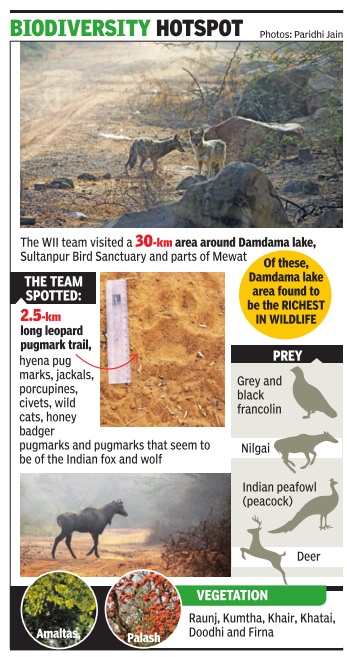
Haryana to allow houses on hillock next to Damdama Any structure on the hill will block flow of rainwater, thereby endangering the future of the water body Dipak Kumar Dash | TNN
Damdama (Gurgaon): Another lake in the Aravalis may soon be consigned to oblivion. If Surajkund and Badhkal lakes succumbed to mining activities in the Aravalis, Damdama, the last surviving water body in the region, may also go dry thanks to the government’s short-sighted policy that will soon facilitate construction in the area.
The revenue department in Gurgaon has almost completed the consolidation (Chakbandi) of plots on a hillock — Roj Ka Gujjar — spread over 5,744 acres adjacent to the lake. This will allow owners to construct houses on their plots. And any structure on the hillock, say environmentalists, will obstruct smooth flow of rainwater, the only source of replenishment, to the lake, almost 40 km from the national capital.
‘‘Any activity in the region will mean that the flow of rainwater to the lake will stop or would be adversely affected. Moreover, people will end up extracting groundwater, which is equally damaging,’’ said R P Balwan, former conservator of forest of southern circle (Gurgaon).
Originally, the hill was commonly owned by residents of 12 villages in the region. ‘‘But almost 90% of the land on the hill has already been sold to outsiders, mostly from Delhi. This had been happening since 1980s. The original owners have sold their shares, though those were not identified. After the consolidation, plots will be demarcated and given to the new individual owners. Those who have bought land are rich and influential people,’’ said a revenue department official.
However, he added that when the department was about to notify consolidation, a scam was detected and the process was put on hold. ‘‘We found that the total land sold was more than the actual area of Roj Ka Gujjar. An additional 631 acres had been sold. The regional commissioner has ordered us to halt the process of handing over of the plots,’’ he added.
The list of discrepancies doesn’t end there. The Ministry of Environment and Forest (MoEF) had written to Haryana government in December 1992 mentioning that all the areas notified under Punjab Land Preservation Act (PLPA) are forests and such areas cannot be used for non-forestry activities without prior permission from the ministry. Though Roj Ka Gujjar is covered under PLPA, its land is now up for consolidation.
Balwan said that construction of any dwelling unit, road or path, electricity poles has also been prohibited. Moreover, the hillock was also covered under Aravali plantation, which has been declared as deemed forest by the Supreme Court. ‘‘The revenue department should not have allowed the sale and purchase of common land since it was not demarcated or fragmented,’’ he added.
But, people who have bought land adjoining the half-dry waterbed of Damdama have started constructing boundary walls. ‘‘In the last few years, more people have bought land around the lake. Things would get worse when more people will occupy the hilltop,’’ cautions Bane Singh, a resident of Damdama village.
Sources said that the revenue department wants to ensure that the drains and streams, which carry rainwater to the lake, are not blocked. ‘‘We have included this in the consolidation scheme so that the natural water supply to the lake is not disturbed. Though consolidation would be finalised soon, land owners would have to get approval for anything they do on their land,’’ said a senior revenue department official.
Wildlife
2017: wildlife density in five districts
In the first survey of its kind on population density of wild animals in five districts of Haryana, the Wildlife Institute of India (WII) has found leopards occupy a 200 square km area in these parts of the Aravalis. And the terrain in Gurgaon and Faridabad districts happens to be their core area.
“Total area under leopard occupancy was estimated to be 200.9 square kilometres.Sites namely Gamroj (Bhondsi), Raipur (Raisina), Mangar, Gothda, Badhkal, Kotla Kansali, Nimatpur (Nayaan), Khol and Panchota have higher psi (population stability index) estimates,“ states the survey report, which was released by chief minister Manohar Lal Khattar and Union environment minister Harsh Vardhan.
“Out of five districts -Gurgaon, Faridabad, Mewat, Rewari and Mahendergarh -the occupancy of leopards is the highest in Gurgaon and Faridabad. Moreover, the core zone (highest used region by the leopard) is also in these two districts,“ said an official of WII who did not wish to be named.
Besides field sampling and analysis, WII used 12 camera traps to track the sightings of wild animals in the Aravalis. As many as seven sightings of leopards were reported in the camera traps within 30 days in October 2016. Moreover, sightings of 13 other species were recorded in the camera traps -seven of striped hyena, nine of golden jackal, 55 of nilgai, seven of palm civet, 14 of wild pig, 55 of rhesus macaque, 57 of peafowl and 12 of the Indian crested porcupine. The camera traps were put up in Bhondsi, Gamroj, Mangar, Bandhwari, Wazirabad, Gothda and Anangpur.
The survey found the jackal to be the highest-occurring carnivore species, followed by the hyena, and nilgai was found to be the highest occurring ungulate in the area. “Jackals are present in almost every grid with 92% occupancy ,“ the report states.
MD Sinha, conservator of forests (Gurgaon circle), said there has definitely been an increase in wildlife population, particularly that of leopards in the area. “There is an area of over 35,000 hectares around Gurgaon, which is very sensitive for wildlife.Seven sightings of big cats in 12 camera traps is a very good number,“ he told TOI.“Also, four successful leopard rescues have been conducted in the last six months by the forest department. There is an immediate need to protect the green cover and lay out a long-term wildlife management plan as wildlife is continuously increasing in the Aravalis,“ he added.
Asked if a wildlife census will be conducted in the Aravalis, Sinha said, “The department has already submitted a plan to conduct a comprehensive study and census of wildlife. We have already submitted a proposal to put radio collars on wild animals.“ The WII report also recommended an immediate end to mining activities in Haryana.
